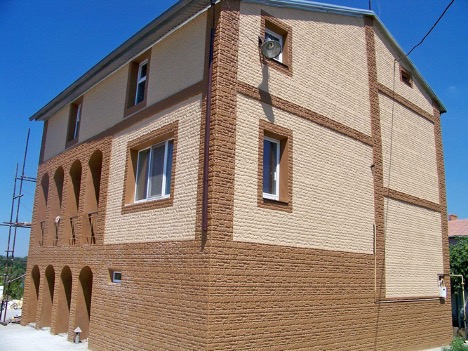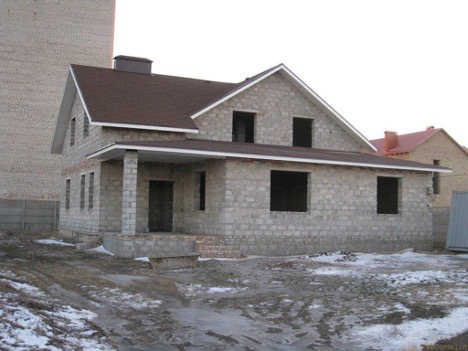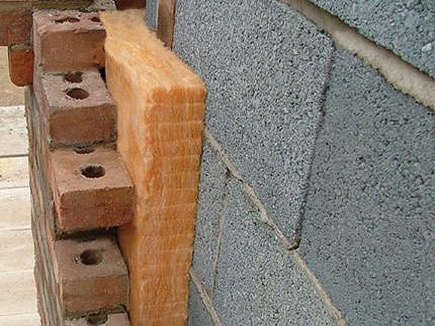Insulating a cinder block house from the outside: how to insulate it and with what material
Insulating the exterior of a cinder block home is a key step in preparing the building for the colder seasons. Cinder block, despite its popularity and availability as a building material, has disadvantages. And one of them is low thermal insulation properties. As a result, without proper insulation, such a house will not be able to effectively retain heat. External insulation helps improve thermal insulation, reduce heat loss and increase overall living comfort.

The content of the article
How to insulate a cinder block house: choosing a method and materials
Before insulating a cinder block house, it is important to choose the right materials and insulation technology. There are several common methods of insulation, each of which has its own advantages:
- Using mineral wool or basalt wool. This is a popular option that provides good heat and sound insulation.
- The use of expanded polystyrene or extruded polystyrene foam. These materials are lightweight, easy to install and have excellent thermal insulation properties.
- Application of liquid polyurethane foam. This method is suitable for creating a seamless insulating "shell" around the house.
Stages of cinder block insulation
Insulating a cinder block house is a multi-step process. Believe me, it requires attention to detail at every step.To achieve the best result and ensure the durability of the insulation, it is important to carefully follow all steps:
The first step in insulating a cinder block is thorough surface preparation:
- The walls must be cleaned of dirt and dust. It is also necessary to remove any remaining paint and other contaminants. This will ensure better adhesion of the insulation materials.
- If there are uneven spots or cracks on the wall, they should be repaired and leveled in advance. This will help avoid “cold bridges” and increase the efficiency of insulation.
Then follows the selection and installation of insulation:
- Depending on preferences and budget, you can choose mineral wool, polystyrene foam or other materials. Each of them has its own advantages and installation features.
- The insulation is attached to the wall. For mineral wool and expanded polystyrene, special glue and additional dowels are usually used for reliability. It is important to ensure that the material fits tightly to the wall without gaps.
The last stage is insulation protection and external finishing:
- A reinforcing mesh and a layer of plaster are applied on top of the insulation. This not only protects the insulation from external influences, but also gives the walls a neat appearance.
- As a final touch, the walls can be painted or lined with decorative materials in accordance with the overall design of the house.
High-quality cinder block insulation will significantly increase the thermal efficiency of the house, reduce heating costs and improve the overall comfort of living.

Mistakes when using insulation in a cinder block house
When insulating a cinder block house, it is important to avoid common mistakes that can reduce the effectiveness of insulation and even lead to damage to the building.Here are some of the most common mistakes:
- Using insulation that is not suitable for cinder block or does not match the climatic conditions can lead to insufficient thermal insulation and increased heat loss.
- Cinder block has a porous structure and can absorb moisture. Failure to provide proper waterproofing before insulation can lead to moisture problems and even wall failure.
- Skips or uneven application of insulation create “cold bridges” through which heat will escape from the house.
- A layer of insulation that is too thin will not provide the desired effect, while a layer that is too thick can lead to unnecessary costs and increased stress on the walls.
- Blocking natural ventilation ducts with insulation can lead to ventilation problems and moisture buildup inside the home.
- An attempt to independently install insulation without the appropriate skills and knowledge can lead to installation errors, reducing the effectiveness of insulation.
- The insulation should be installed in dry weather to prevent moisture from getting under the insulating layer.
By avoiding these mistakes, you can significantly increase the efficiency of insulation of a cinder block house, ensure comfortable living in it and extend the service life of the building itself.
Rating of Russian manufacturers of insulation for the exterior of a cinder block house
Creating an accurate rating of Russian manufacturers of insulation for a cinder block house can be difficult, given the diversity of preferences and evaluation criteria among users and experts. Nevertheless, there are several names that are often mentioned among the leading manufacturers of insulation in Russia:
- TechnoNIKOL is one of the largest manufacturers of building materials in Russia and Europe, including a wide range of insulation materials such as mineral wool and extruded polystyrene foam.
- Isorok is engaged in the production of mineral wool and is known for its high-quality insulation solutions for various construction needs.
- URSA offers a wide range of insulation materials, including glass wool and mineral wool. And they are suitable for external insulation of cinder block houses.
- Knauf Insulation is a German brand with production in Russia. It offers mineral wool types that are high quality and efficient.
- Rockwool is a Danish company with production facilities in Russia, known for its stone wool insulation. They are widely used in construction.
These companies have earned recognition in the Russian market due to the quality of their products, innovative technologies and a wide range of insulation materials suitable for various operating conditions. When choosing insulation from Russian manufacturers, it is important to take into account factors such as thermal conductivity, vapor permeability, fire safety and environmental friendliness of materials.
Conclusion: advantages of insulating a cinder block house
Insulating a cinder block house not only increases living comfort, but also helps save on heating costs. Properly selected and high-quality installed insulation significantly reduces heat loss, providing warmth in winter and coolness in summer. In addition, it also helps to increase the overall value of the property and its attractiveness in the market.





